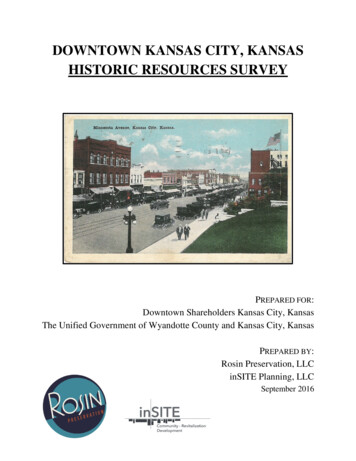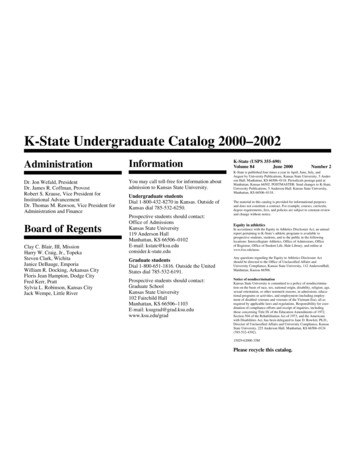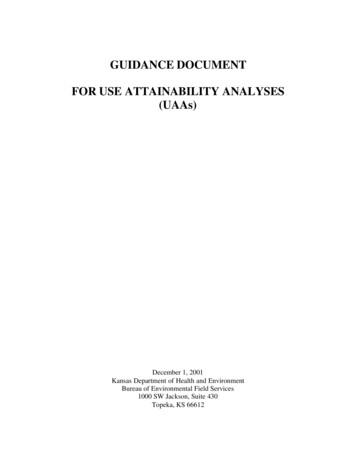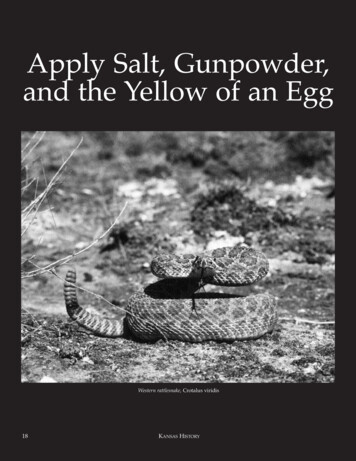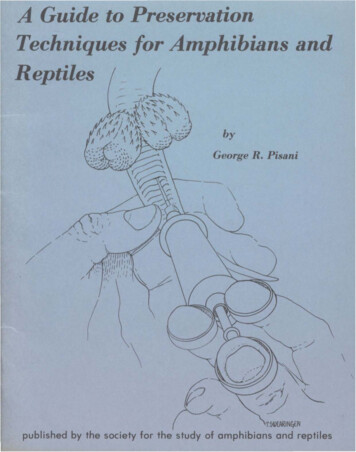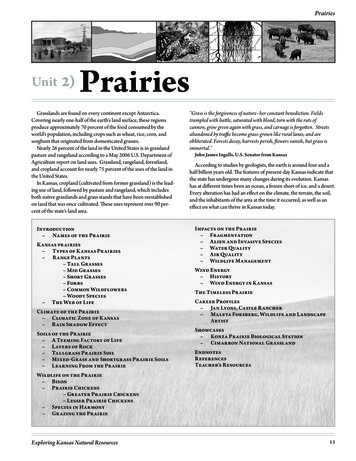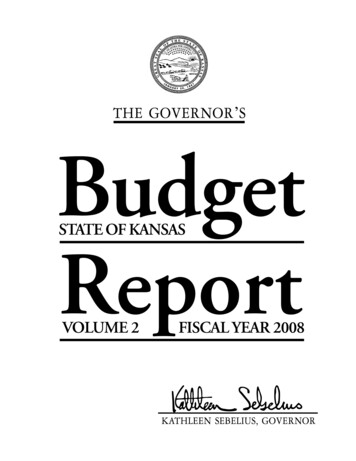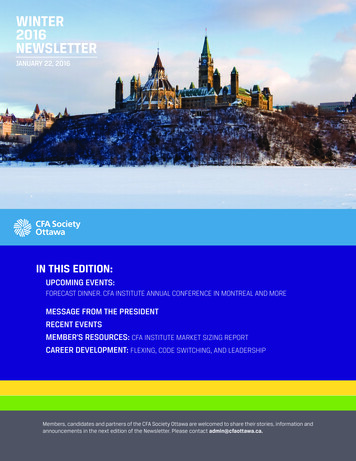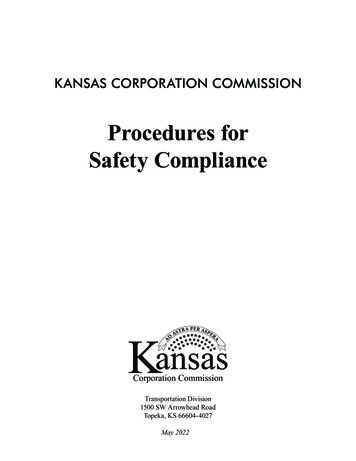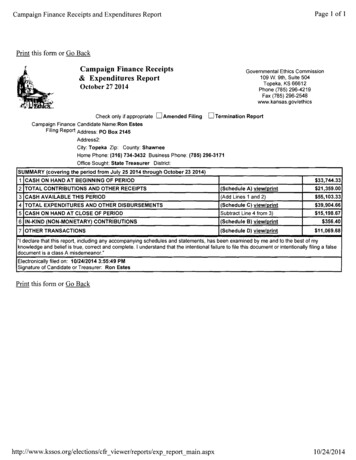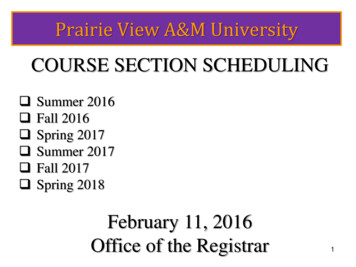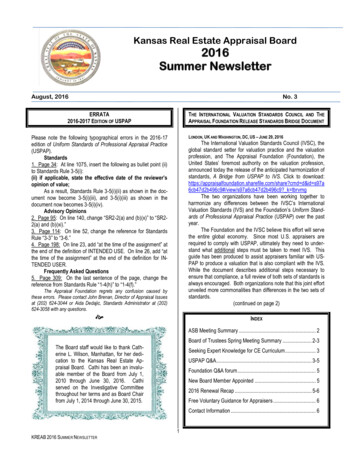
Transcription
Kansas Real Estate Appraisal Board2016Summer NewsletterAugust, 2016No. 3ERRATA2016-2017 EDITION OF USPAPTHE INTERNATIONAL VALUATION STANDARDS COUNCIL AND THEAPPRAISAL FOUNDATION RELEASE STANDARDS BRIDGE DOCUMENTLONDON, UK AND WASHINGTON, DC, US – JUNE 29, 2016Please note the following typographical errors in the 2016-17edition of Uniform Standards of Professional Appraisal Practice(USPAP).Standards1. Page 34: At line 1075, insert the following as bullet point (ii)to Standards Rule 3-5(i):(ii) if applicable, state the effective date of the reviewer’sopinion of value;As a result, Standards Rule 3-5(i)(ii) as shown in the document now become 3-5(i)(iii), and 3-5(i)(iii) as shown in thedocument now becomes 3-5(i)(iv).Advisory Opinions2. Page 95: On line 140, change “SR2-2(a) and (b)(x)” to “SR22(a) and (b)(xi).”3. Page 114: On line 52, change the reference for StandardsRule “3-3” to “3-6.”4. Page 198: On line 23, add “at the time of the assignment” atthe end of the definition of INTENDED USE. On line 26, add “atthe time of the assignment” at the end of the definition for INTENDED USER.Frequently Asked Questions5. Page 309: On the last sentence of the page, change thereference from Standards Rule “1-4(h)” to “1-4(f).”The International Valuation Standards Council (IVSC), theglobal standard setter for valuation practice and the valuationprofession, and The Appraisal Foundation (Foundation), theUnited States’ foremost authority on the valuation profession,announced today the release of the anticipated harmonization ofstandards, A Bridge from USPAP to IVS. Click to /share?cmd d&id s97a6cb47d2b496c9#/view/s97a6cb47d2b496c9? k tbrvmgThe two organizations have been working together toharmonize any differences between the IVSC’s InternationalValuation Standards (IVS) and the Foundation’s Uniform Standards of Professional Appraisal Practice (USPAP) over the pastyear.The Foundation and the IVSC believe this effort will servethe entire global economy. Since most U.S. appraisers arerequired to comply with USPAP, ultimately they need to understand what additional steps must be taken to meet IVS. Thisguide has been produced to assist appraisers familiar with USPAP to produce a valuation that is also compliant with the IVS.While the document describes additional steps necessary toensure that compliance, a full review of both sets of standards isalways encouraged. Both organizations note that this joint effortunveiled more commonalities than differences in the two sets ofstandards.(continued on page 2)The Appraisal Foundation regrets any confusion caused bythese errors. Please contact John Brenan, Director of Appraisal Issuesat (202) 624-3044 or Aida Dedajic, Standards Administrator at (202)624-3058 with any questions. INDEXASB Meeting Summary . 2Board of Trustees Spring Meeting Summary . 2-3The Board staff would like to thank Catherine L. Wilson, Manhattan, for her dedication to the Kansas Real Estate Appraisal Board. Cathi has been an invaluable member of the Board from July 1,2010 through June 30, 2016. Cathiserved on the Investigative Committeethroughout her terms and as Board Chairfrom July 1, 2014 through June 30, 2015.Seeking Expert Knowledge for CE Curriculum . 3USPAP Q&A . 3-5Foundation Q&A forum . 5New Board Member Appointed . 52016 Renewal Recap . 5-6Free Voluntary Guidance for Appraisers . 6Contact Information . 61KREAB 2016 SUMMER NEWSLETTER
Sir David Tweedie, Chair of the IVSC, said “The release ofthis bridging document marks an important step towards ourobjective of establishing globally accepted valuation standards.Valuations underpin economies by providing investors and businesses with the information they need to make informed decisions. With so many different methods and approaches forvaluation across the world it is difficult for many internationalbusinesses to understand the true value of assets, so our workto harmonize valuation standards is crucial to aiding businessand the smooth functioning of markets worldwide. We lookforward to working further with The Appraisal Foundation andachieving our common goals.”“While there are varying regulatory environments, business practices and cultures among the world’s economies, webelieve that core valuation standards should transcend thesedifferences,” stated David Bunton, President of The AppraisalFoundation. “The members of our respective Standards Boardshave dedicated a great deal of time and effort to this harmonization project and their efforts on behalf of the global valuationprofession should be recognized,” he added.The document will be amended to be consistent with updates to the Standards as they occur.ASB MEETING SUMMARYOn June 17, 2016, the Appraisal Standards Board (ASB)held its second public meeting of the year. The Board discussed the First Exposure Draft of proposed changes for the2018-19 edition of the Uniform Standards of Professional Appraisal Practice, which included proposed revisions in the following areas of USPAP: Definition of Report Definition of Assignment Extraordinary Assumptions STANDARD 3 – Dividing into STANDARD 3, AppraisalReview, Development, and STANDARD 4, Appraisal Review, Reporting STANDARD 6 – Dividing into STANDARD 5, Mass Appraisal, Development, and STANDARD 6, Mass Appraisal,Reporting Standards Rule 8-3 Advisory Opinion 37, Computer Assisted Valuation ToolsThe Board also accepted oral comments from meetingattendees. The Board encouraged the public to send any suggested USPAP revisions toASBComments@appraisalfoundation.org.Click below for a detailed meeting share?cmd d&id s8887fd7d7794d668#/view/s8887fd7d7794d668? k gz5y5g.Upcoming meeting: ASB Public Meeting, October 21,2016, 9:00 a.m. to 12:00 p.m., Washington, DC.About the International Valuation Standards Council (IVSC)The International Valuation Standards Council (IVSC) isan independent, not-for-profit, private sector organization. Asthe established international standards setter for valuation, theIVSC develops and maintains standards for the reporting anddisclosure of valuations, especially those that will be relied uponby investors and other third party stakeholders in financialstatements or other published documents.It is developing a framework of guidance on best practicefor valuations of the various classes of assets and liabilities. Topromote the consistent delivery of the standards by properlytrained professionals around the globe, the IVSC is also establishing international benchmarks for the conduct and competency of professional valuers.The governance structure of the IVSC includes two independent technical Boards – the International Valuation Standards Board and the International Valuations Professional Board– and a global Board of Trustees responsible for the overallstrategic direction and funding of the IVSC. For more information please visit: www.ivsc.org. THE APPRAISAL FOUNDATION’S BOARD OF TRUSTEES SPRINGMEETING SUMMARYBelow is a summary of some of the major issues addressed at the Spring Meeting of the Board of Trustees of TheAppraisal Foundation, which was held May 14, 2016 in Naples,FL.The following individuals were elected as At-Large members of the Board of Trustees for three-year terms beginning onJanuary 1, 2017: Larry Disney, Kentucky Mark Levine, Colorado Dayton Nordin, MassachusettsThe following individuals were appointed to the AppraisalPractices Board (APB), with all terms beginning July 1, 2016: Shawn Wilson, Florida Lisa Desmarais, Colorado Greg Franceschi, California Greg Graybadger, IdahoPress contact for IVSC:Rolf Merchant/Jeremy Durrant, Instinctif PartnersTelephone: 44 (0)20 7457 2020 / 44 (0)7753 940 880 / 44(0) 7792 918 488E-mail: Rolf.Merchant@instinctif.com or Jeremy.Durrant@instinctif.comPress Contact for The Appraisal Foundation:Paula Douglas SeidelTelephone: (202) 624-3048E-Mail: paula@appraisalfoundation.org25th Anniversary of the Implementation of FIRREAThe Financial Institutions Reform, Recovery, and Enforcement Act (FIRREA) was enacted in 1989 and implementedin 1991. Therefore, 2016 marks the 25th anniversary of the fullimplementation of this unique real property appraiser regulatorysystem. The three primary partners in the regulatory system(AARO [Assoc. of Appraiser Regulatory Officials]; ASC [Ap- 2KREAB 2016 SUMMER NEWSLETTER
praisal Subcommittee]; and the Foundation) are jointly workingon a publication that highlights the numerous accomplishmentsof the past quarter century. The report will be available in theFall of 2016. Common Myths about Appraisals in the Home Buying Process Fun Facts for Future AppraisersPlease contact Paula Douglas Seidel(paula@appraisalfoundation.org) if you are interested in obtaining copies of these publications.Appraisal Institute RelationsChair David Layne is leading the Foundation’s efforts torepair the relationship with the Appraisal Institute. Leadership ofboth organizations have committed to regularly meet to findcommon ground and identify actions to pursue for the good ofthe profession. SEEKING EXPERT KNOWLEDGEFOR APPRAISAL CE CURRICULUMFederal Government ContractsUS Department of JusticeThe US Department of Justice (DOJ) is moving forward with itsrevisions to the Uniform Appraisal Standards for Federal landAcquisitions (UASFLA), more commonly known as the “YellowBook.” They expect to issue an exposure draft shortly and hopeto have final adoption by early September 2016. The DOJ isaiming to have the next edition of the Yellow Book available byNovember 1, 2016. As the publisher, we will offer this documentin both print and electronic versions.US Department of EnergyOur five year Memorandum of Understanding (MOU) withthe US Department of Energy (DOE) is set to expire in June. Aspart of that agreement, the APB is to offer guidance on the valuation of green or high-performance properties. Two ValuationAdvisories have already been issued: (1) Valuation of Greenand High Performance Property: Background and Core Competency, and (2) Valuation of Green and High Performance Property: One to Four-Unit Residential. The Board recently issuedan exposure draft of the third valuation advisory in the series,Valuation of Green and High Performance Property, NonResidential Property.Ryan Nuhfer is the head of the Author Acquisitions department for the Colibri Group. They create continuing education curriculum for a variety of professions. He locates and thenmanages dozens of writers who create the courses for theseprofessions.Colibri’s Real Estate and Appraisal brand, McKissockLearning, is seeking experienced appraisers with an interest inauthoring courses on various appraisal topics. Writing experience is not necessary (though it is preferred).If interested, please send your related experience and/orideas for courses you would like to see toryan.nuhfer@colibrigroup.com. USPAP Q & AThe Appraisal Standards Board (ASB) of The Appraisal Foundation develops,interprets, and amends the Uniform Standards of Professional Appraisal Practice(USPAP) on behalf of appraisers and users of appraisal services. TheUSPAP Q&A is a form of guidance issued by the ASB to respond to questionsraised by appraisers, enforcement officials, users of appraisal services and thepublic to illustrate the applicability of USPAP in specific situations and tooffer advice from the ASB for the resolution of appraisal issues and problems. The USPAP Q&A may not represent the only possible solution tothe issues discussed nor may the advice provided be applied equally to seemingly similar situations. USPAP Q&A does not establish new standards orinterpret existing standards. USPAP Q&A is not part of USPAP and isapproved by the ASB without public exposure and comment.Software Vendor License AgreementsA year ago partnerships were announced with three technology vendors who agreed to incorporate USPAP into theirappraisal software and in return for the Foundation’s intellectualproperty, pay a fee. Since that time each vendor has been preparing to get this product to market. We anticipate seeing thefirst of these products (ACI Sky Writer) in the next few weeks.Products from Centric and Bradford Technologies will follow.After these initial partnerships are available, the Foundation willexplore additional partnerships with vendors who have an interest in doing something similar.Public TrustThe expression “public trust” is used in USPAP. What isQ.publictrust and who or what is the public in the USPAPcontext?USPAP mentions public trust three times. The PREAMBLE states that the purpose of USPAP is to “ promoteand maintain a high level of public trust in appraisal practice byestablishing requirements for appraisers.” The PREAMBLE alsostates “The appraiser’s responsibility is to protect the overallpublic trust and it is the importance of the role of the appraiserthat places ethical obligations on those who serve in this capacity.” Lastly, the ETHICS RULE reinforces this concept with “Anappraiser must promote and preserve the public trust inherent inappraisal practice by observing the highest standards of professional ethics.”While USPAP does not define public trust, it is clear fromthe context that it refers to the need for the public to be able tohave confidence that services provided by an appraiser are performed competently and in a manner that is independent, impar-A.Brochures, Factsheets and InfographicsThe Foundation has a number of complimentary publicationsthat are available on its web site or in print for a small fee. Thefollowing brochures are currently available: How to Enter the Appraisal Profession Why Engage a Professional Appraiser A Guide to Understanding a Residential Appraisal Appraisers, Appraisals & You: A Lender’s Guide to USPAP Valuation of Gems and Jewelry Valuation of Fine and Decorative Art Valuation of Machinery and Equipment Foundation Factsheets3KREAB 2016 SUMMER NEWSLETTER
tial, and objective.The public, whose trust the appraiser must promote andpreserve, exists on several levels. The most direct is the appraiser’s client. In addition to the client, any additional intendedusers would be part of the appraiser’s public. But, evenbeyond the client and other intended users, there are otherparties who may rely on the work an appraiser and the appraiser must be careful not to mislead such third parties. Finally, it could be said that the general public is also part ofthat public. If the general public cannot depend on appraisers to act as independent professionals and provide credibleresults, the economy could suffer.Revision of Previously Published (2015-12) Q&A:fact, there was only one sale within the 3-year periQ.od,If, inmustthe appraisal report state that there were noadditional sales?A.Must the appraisal report include a statement that thereQ.wereno sales of the subject within the 3-year period if, infact, there were none?No. USPAP does not require an appraiser to state in thereport that there have been no sales within the 3-yearperiod.As the client you may, of course, require that the appraiser exceed USPAP requirements by including an affirmativestatement about the absence of other sales.A.In October 2015, the ASB published Q&A 2015-12, Appraising Two Lots as One. The response to the question hasbeen revised to more clearly convey the ASB’s guidance. Thequestion and the revised answer are included below, with deletions shown in strikethrough text and additions shown in underlined text. These changes will also be reflected in the Q&Ason The Appraisal Foundation’s website.Trainee / Supervisor RequirementsCan a Trainee Appraiser inspect a property without aQ.SupervisoryAppraiser?A.Appraising Two Lots as OneYes; however, the Trainee Appraiser must be competentto do so. The Criteria require Supervisory Appraisers topersonally inspect properties along with Trainees until theTrainee is competent to do so without supervision. The Criteriamandate such supervision to include:Personally inspecting each appraised property with theTrainee Appraiser until the Supervisory Appraiser determinesthe Trainee Appraiser is competent to inspect the property, inaccordance with the COMPETENCY RULE of USPAP for theproperty type.Competency to inspect without supervision will vary fromassignment-to-assignment. For example, after numerous assignments a supervisor may deem a trainee competent to inspect single-unit residential tract-type homes.However,that does not mean the trainee is competent to perform inspections without supervision for large custom homes, condominiums, 2-4 unit residential properties, or atypical/complexproperty types or assignments. Competency to inspect aproperty is determined by the Supervisory Appraiser on anindividual assignment basis.a lender client that wants a market value appraisQ.alI havecompleted. The property consists of two separatelegal lots. The highest and best use for each of these lots is as aseparate one-unit residential site. However, the client wantsthem appraised as though they were one legal lot. The intendeduse is for mortgage lending purposes.May this assignment be completed treating these two lotsas if they were one legal lot with the highest and best use asone legal lot?If the appraiser knows that the highest and best use ofthe properties is as two separate one-unit residentialsites, then Yes. However, complying with the lender’s requestwill require use of a hypothetical condition. If the client is a federally regulated financial institution, it will the client may alsoneed an “as-is” appraisal.If the appraisal were based on a hypothetical condition(i.e., market value of the subject as if it were a single lot), and ifnecessary for credible results, the appraiser would have to develop an opinion of highest and best use of the hypotheticalparcel. If this leads to the conclusion that the highest and bestuse would be subdivision into two or more lots, the appraisermust perform the appraisal recognizing that potential use andmay need to perform a subdivision analysis to reach a credibleopinion of the highest and best use of the hypothetical parcel.A.Important Note: Kansas regulations require that a supervisor personally inspect a minimum of the first 25 appraisalsin which the trainee substantially contributes.Q. Can a Trainee Appraiser sign an appraisal report?Subject Property Sales History and Standards Rule 1-5(b)Yes, and the Supervisory Appraiser must co-sign theappraisal report. This is required regardless of whetherthe Supervisory Appraiser personally inspected the property.A.We often receive appraisal reports where a prior sale ofthe subject property is addressed. However, the reports do notinclude an affirmative statement that there have been no othersales within the three years prior to the effective date of theassignment. The appraisers believe they are in compliancewith USPAP as they have appropriately addressed a prior sale.As the client, I do not agree.Scope Of PracticeQ.as:I was asked to appraise a “condotel,” which is defined4KREAB 2016 SUMMER NEWSLETTERNo, USPAP does not require an appraiser to state in thereport that there were no additional sales.
A hotel in which an investor takes title to aspecific hotel room (unit), which remains in thepool to be rented to transient guests whenever theinvestor is not using the unit.1Is the appraisal of an individual condotel unit a residentialor non-residential assignment?prior to becoming a residential appraiser in 1974. He is a certified residential appraiser with an SRA designation from theAmerican Institute of Real Estate Appraisers. Mr. Samuelsonhas served as president of the Appraisal Institute Greater Kansas Chapter; president of the Wichita Area Assoc. of Realtors;president of the South Central Kansas Multi List System; and aKansas Assoc. of Realtors board member. He is a member ofthe National Assoc. of Realtors and the National Assoc. ofHome Builders, and has been an expert witness in Kansas andArkansas courts. He was given the Walter Morris Realtors of theYear award in 2005. Mr. Samuelson and his wife, Barbara, havetwo children and four grandchildren. His term will expire on June30, 2019.If the marketplace recognizes the units individually asresidential units, the appraisal would be considered aresidential assignment. If the marketplace does not recognize the units individually, but rather as a part of the overall hoteloperation, then the assignment would be non-residential. Ineither case, appraisers performing such assignments mustfully understand the ownership rights associated, as wellas the interest(s) being appraised.As with all assignments, appraisers must comply with USPAP,including the COMPETENCY RULE.A. The reader is advised that in all cases, the above responsesare based upon the minimum criteria adopted by the AQB.Individual states can adopt more stringent requirements.Please check with the state appraiser regulatory agency inyour state to confirm their specific requirements.Alan D. ClarkJanuary 29, 1966 – February 21, 2016Alan Dwane Clark, 50, passed awayon February 21, 2016 at GardenPlain, Kansas. Mr. Clark was issueda Provisional Trainee license onMarch 22, 2004 and his State License on November 8, 2005. A Certified Residential license was issuedto Mr. Clark on March 10, 2010, andit remained in effect until his death.The USPAP Q&A is posted on The Appraisal Foundation website(www.appraisalfoundation.org). The ASB compiles the USPAP Q&A into theUSPAP Frequently Asked Questions (USPAP FAQ) for publication with eachedition of USPAP. In addition to incorporating the most recent questions andresponses issued by the ASB, the USPAP FAQ is reviewed and updated toensure that it represents the most recent guidance from the ASB. The USPAPFrequently Asked Questions can be purchased (along with USPAP and USPAPAdvisory Opinions) by visiting the “Foundation Store” page on The AppraisalFoundation website (https://commerce.appraisalfoundation.org) APPRAISAL FOUNDATION Q&A FORUMOn July 11, 2016, the Foundation announced the availability of a new Q&A forum. You can post your questions onappraisal standards or appraiser qualifications and receive atimely answer from Foundation Staff. The Q&A forum is anothergreat way for you to interact with the Foundation boards.For more information on the Forum and how to register,please visit the Q&A webpage located ndards/Q As/TAF/QAs.aspx.To access the Forum directly, visithttp://www.appraisal.answerbase.com/.2016 RENEWAL RECAPMay 31, 2016, saw the end of the 2016 on-time renewalperiod. 1,031 renewal applications were mailed out on March 3,2016 with an additional 16 sent out to new appraisers issuedafter that date. On June 30, 2016, 58 records were cancelleddue to non-renewal, 16 of which have since been renewed.CONTINUING EDUCATIONAs 2016 was an “off-cycle” for continuing education (CE),no log was required. Keep in mind that the 2017 renewal willrequire that appraisers licensed/certified for a period of morethan one (1) year must log 28 hours at that time. USPAP Update (7 hours) must be included in the total 28 hours. Appraisers license/certified for less than one (1) year must meet 14hours, 7 of which must be in USPAP Update. Appraisers licensed/certified for less than 185 days (from the date of expiration) are exempt from CE at their first renewal. Renewal applications during on-cycle years are specific to each appraiser’sCE requirements.There are three (3) possible beginning dates for a continuing education cycle. If you have gone through an on-cycle forcontinuing education and you renewed on or prior to June 30,2015, July 1, 2015 would mark the beginning of the 2017 CE NEW BOARD MEMBER APPOINTED FOR 2016-2019 TERMFred L. Samuelson, Wichita, was appointed as an appraisermember to the Kansas Real Estate Appraisal Board on July 1,2016. Mr. Samuelson is the owner of The Appraisal Companyin Wichita. He graduated from the University of Kansas andserved an active duty tour with the Kansas Air National GuardDictionary of Real Estate Appraisal, 6th ed. Chicago: AppraisalInstitute, 2015.15KREAB 2016 SUMMER NEWSLETTER
cycle for you. If you renewed on or after July 1, 2015, the dateof your 2015 renewal would mark the beginning of the 2017 CEcycle. If you have not gone through an on-cycle for continuingeducation, then the beginning date for acceptable CE is theoriginal Kansas issue date. This information is included on therenewal application.Classroom courses completed outside the state of Kansasmay be used to meet CE; however, on-line courses completedby Kansas residents, must carry Kansas approval. A nonresident appraiser may use on-line CE provided it was approvedeither by Kansas or by their resident state.The biggest problem we encounter during on-cycle renewals is in the information provided on the log. An incorrectlyentered completion date can result in denial of CE.When entering the name of the CE provider, be awarethat not all courses completed by a chapter of an organizationare necessarily approved for the national organization. In otherwords, use the certificate of completion when entering your CEdata. It is always recommended that you confirm approval of acourse prior to registering for same. Make sure that your certificate of completion reflects the correct provider name, coursetitle, hours granted, and the date of completion.Courses titles are also extremely important. If you completed the course “Application & Interpretation of Simple LinearRegression” but entered “Simple Linear Regression,” it is likelythat we would not match it to an approved course. Again, thiscan result in denial of CE.APB Valuation Advisory #6:Valuation of Green and High Performance Property: Background and Core CompetencyAPB Valuation Advisory #7:Valuation of Green and High Performance Property: One-toFour-Unit ResidentialThe APB utilizes teams of Subject Matter Experts (SMEs)to help develop this guidance. To learn more about the APB’sValuation Advisories and what advisories are under development, click on the following esources/Guidance/TAF/Valuation Advisories.aspx?hkey d74f24ae-8dcb412e-947f-6df153626ae2KANSAS APPRAISERS AND AMCSAS OF AUGUST 24, 2016CERTIFIED GENERAL. 477CERTIFIED RESIDENTIAL. 427STATE LICENSED . 104PROVISIONAL (TRAINEE) . 10TOTAL . 1018APPRAISAL MANAGEMENT COMPANIES . 126 KANSAS REAL ESTATE APPRAISAL BOARDJAYHAWK TOWER700 SW JACKSON, STE. 804TOPEKA, KS 66603(785) 296-6736 (PHONE)(785) 368-6443 (FAX)http://www.kansas.gov/kreabFREE VOLUNTARY GUIDANCE FOR APPRAISERSThe Appraisal Foundation’s Appraisal Practices Board(APB) has issued Valuation Advisories, which are available forfree on the Foundation’s web site. The following Valuation Advisories are currently available:RICHARD LIVINGSTON, CHAIRJIM STALLBAUMER, VICE-CHAIRJEFF CAUDLE, MEMBERROBIN TAGGART HANNIGAN, MEMBERKENTON LADENBURGER, MEMBERFRED L. SAMUELSON, MEMBERAPB VRF Valuation Advisory #1:Identification of Contributory Assets and Calculation of Economic RentsAPB VFR Valuation Advisory #1 (Toolkit):Identification of Contributory Assets and Calculation of Economic RentsSTAFFSALLY PRITCHETT, EXECUTIVE DIRECTORsally.pritchett@ks.govCHERYL MAGATHAN, PUBLIC SERVICE EXECUTIVEcheryl.magathan@ks.govAPB VFR Valuation Advisory #2:The Valuation of Customer-Related AssetsAPB Valuation Advisory #2:Adjusting Comparable Sales for Seller ConcessionsTHE APPRAISAL FOUNDATION1155 15TH ST. N.W., STE. 1111WASHINGTON, DC 20005(202) 347-7722 (PHONE)APB Valuation Advisory #3:Residential Appraising in a Declining isalfoundation.orgAPB Valuation Advisory #4:Identifying Comparable Properties – RevisedTHE NATIONAL AnAppraiser.aspxAPB Valuation Advisory #5:Identifying Comparable Properties in Automated Valuation Models for Mass Appraisal6KREAB 2016 SUMMER NEWSLETTER
KREAB 2016 SUMMER NEWSLETTER 201 August, 2016 No. 3 ERRATA 2016-2017 EDITION OF USPAP Please note the following typographical errors in the 2016-17 edition of Uniform Standards of Professional Appraisal Practice (USPAP). Standards 1. Page 34: At line 1075, insert the fol
